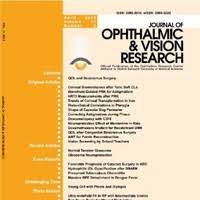Hyperopia and Lens Power in an Adult Population: The Shahroud Eye Study
Authors
Affiliations
1Department of Ophthalmology, Centro Médico San Luis, Buenos Aires, Argentina.
2Noor Ophthalmology Research Center, Noor Eye Hospital, Tehran, Iran; Farabi Eye Hospital, Tehran University of Medical Sciences, Tehran, Iran.
3Noor Ophthalmology Research Center, Noor Eye Hospital, Tehran, Iran.
4Research School of Biology, College of Medicine, Biology and Environment, Australian National University, Canberra, Australia.
5Department of Epidemiology, School of Public Health, Shahroud University of Medical Sciences, Shahroud, Iran.
6Department of Community Medicine, School of Medicine, Tehran University of Medical Sciences, Tehran, Iran.
7Department of Epidemiology and Biostatistics, School of Public Health, Tehran University of Medical Sciences, Tehran, Iran.
Abstract
Purpose: To explore the relationship between lens power and refractive error in older adults following age-related hyperopic shifts.
Methods: From the Shahroud Eye Cohort Study, subjects aged 55-64 years without clinically significant cataracts (with nuclear opacity of grade 0 to 1) were included to maximize the proportion of subjects with age-related hyperopic shifts that normally occur between 40 to 60 years of age, before interference from the myopic shift due to nuclear cataracts. Mean axial length (AL) values, corneal power, anterior chamber depth, lens thickness, and lens power were analyzed and compared among three refractive groups (myopes, emmetropes, and hyperopes).
Results: A total of 1,006 subjects including 496 (49.63%) male subjects were studied. Corneal power was similar in all refractive groups. Hyperopes had + 1.69 diopters higher mean spherical equivalent refractive error and – 0.50 mm shorter AL than emmetropes. Myopes had 0.67 mm longer AL than emmetropes. Hyperopes had significantly increased lens thickness as compared to emmetropes (4.42 vs. 4.39 mm respectively). In this adult sample, the hyperopic group had lower lens power (+22.29 diopters vs. +22.54 diopters in emmetropes, P = 0.132). Myopes had similar lens power as emmetropes.
Conclusion: Axial length is the principal determinant of refractive errors. Lens power may have importance in determining hyperopia in adults free of cataract.
Keywords: Cross-sectional Study; Hyperopia; Lens Power.

